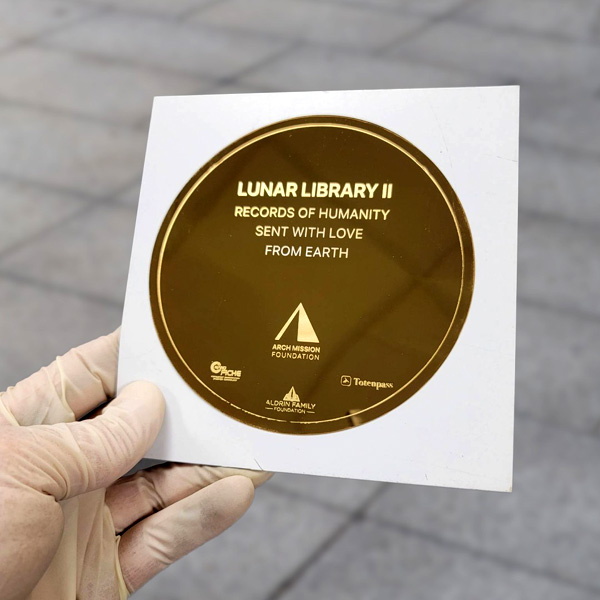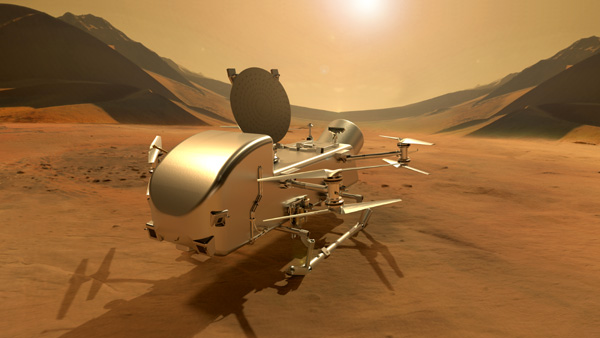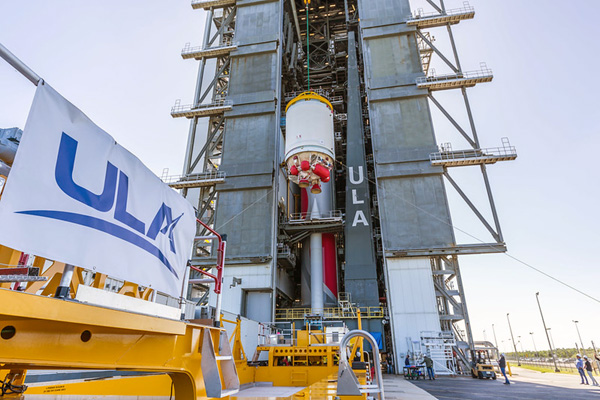 Arch Mission Foundation / Nova Spivack
Arch Mission Foundation Prepares Lunar Library II for December 2023 Launch (Press Release)
The second Lunar Library™ will put additional civilizational archives on the Moon with Astrobotic's first lunar mission.
CAMBRIDGE, Mass. /PRNewswire-PRWeb/ --
Arch Mission Foundation / Nova Spivack
Arch Mission Foundation Prepares Lunar Library II for December 2023 Launch (Press Release)
The second Lunar Library™ will put additional civilizational archives on the Moon with Astrobotic's first lunar mission.
CAMBRIDGE, Mass. /PRNewswire-PRWeb/ -- The Arch Mission Foundation announced today that its second installment of the historic
Lunar Library will launch to the Moon's surface later this year aboard Astrobotic's
Peregrine Lander. The launch is currently scheduled for December 24, 2023 from Cape Canaveral's Space Launch Complex 41
(SLC-41).
The Lunar Library is capable of lasting for up to billions of years on the Moon, and this is the second installment, expanding upon the first Lunar Library launched aboard Israel's
Beresheet Lander in 2019. The Lunar Library is an instance of
The Billion Year Archive initiative, which aims to build a solar-system-wide library system that can preserve, connect and share humanity's knowledge for billions of years.
The second Lunar Library archives over 60 million pages, including foundational components like the Wikipedia, collections from Project Gutenberg, the Internet Archive and the Long Now Foundation's Rosetta Project and PanLex datasets, which provide a linguistic key to 5000 languages with 1.5 billion cross-language translations. Additionally, the new Lunar Library will include archives of music and film.
The library also features the "Aldrin Archive" in partnership with the Aldrin Family Foundation, which includes images from the
Apollo 11 mission as well as space-themed STEAM projects from K-12 Students.
Additional content partners for the
Lunar Library II include the SETI Institute's The Earthling Project, CATALOG, Memory of Mankind, LifeShip, the Great Pause Project, the Molecular Information Systems Lab at the University of Washington, and more.
"We're thrilled to be launching the Lunar Library for our second attempt to land it on the Moon, this time with our partners at Astrobotic," said Arch Mission Foundation Co-founder & Chairman Nova Spivack. "After we land the Lunar Library on the Moon, we can guarantee, for the first time in human history, that humanity's heritage will be safely preserved, no matter what happens on Earth."
Astrobotic will carry the Lunar Library II to the Moon on its Peregrine Lunar Lander and store it on the lunar surface. Astrobotic's inaugural lunar mission will also include a manifest of payloads from NASA, companies, universities, nonprofits and individuals.
The Lunar Library is being deployed to deliver extremely long-duration archives containing curated collections of public and private libraries and other time-capsules to the Moon. The Library will continue to be regularly updated with additional installments to various destinations around the surface of the Moon, across a series of lunar landings by a variety of commercial entities, nonprofit organizations and governments.
"We have a moral obligation as a species to provide a backup of human civilization so that our knowledge, wisdom and culture will exist far beyond us," says Matthew Hoerl, Arch Mission Co-founder and Executive Director. "The Arch Mission is dedicated to preserving humanity's heritage for future generations and civilizations to discover. The Billion Year Archive is an ambitious project, but we now have the technology and capabilities to achieve this long-term preservation of our unique human record no matter what our future may hold."
A duplicate disc of the Lunar Library II will be donated to the Smithsonian's National Air and Space Museum, where the public will be able to see it displayed alongside other vital artifacts related to the human future in space.
The Lunar Library II consists of top layers consisting of tens of thousands of pages of text and images stored as analog NanoFiche images on thin sheets of nickel. Each page is etched by laser using patented technology provided to the Arch Mission Foundation by Stamper Technology.
In addition to the analog etchings, the library also includes 60 million pages of digital data etched into nickel as well.
"Durability is the foundation of the Arch Libraries, and the licensed NanoFiche technology provides a material base for the archives that can last for billions of years, even under the harshest environmental conditions," said Bruce Ha, the Arch Mission Foundation's Chief Scientist. "Nickel is impervious to radiation as well as the changing temperatures on the Moon, and can last for billions of years in space. The analog content of the Library can easily be read via a 100x magnification optical microscope, without needing a computer, so that it is accessible with even the most rudimentary tools."
In addition to the nickel NanoFiche technology, the Lunar Library II also utilizes other storage technologies, including data stored in molecular form using new DNA storage technology.
"In 2018, we identified Astrobotic as a key partner for the Arch Mission and one that was most likely to succeed in delivering a commercial lander to the lunar surface," says Robert Jacobson, Arch Mission Operations Lead and author of the book
Space Is Open for Business. "The commercial space industry is still nascent, similar to the early days of the internet. Astrobotic is providing critical infrastructure so groups like ours can leverage with new applications. We commend the team at Astrobotic for their important work to send the first lunar lander from the United States since the
Apollo missions."
The Lunar Library II follows the Arch Mission's initial Lunar Library launch in 2019, and the first
Solar Library, launched aboard SpaceX's first
Falcon Heavy flight earlier in 2018. In 2021, the Arch Mission Foundation's first terrestrial Earth Archive, the
Lava Library, was placed in the lava tubes of Hawaii's Mauna Loa volcano by the
Valoria I mission crew of HI-SEAS during a Mars simulation mission.
Source: PRWeb.com
****
 Arch Mission Foundation / Nova Spivack
Arch Mission Foundation / Nova Spivack




































